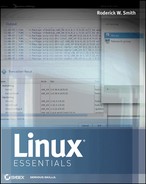CONTENTS
CHAPTER 1 Selecting an Operating System
Using a Text-Mode User Interface
Using a Graphical User Interface
Where Does Linux Fit in the OS World?
Creating a Complete Linux-Based OS
A Summary of Common Linux Distributions
CHAPTER 2 Investigating Linux's Principles and Philosophy
Understanding Basic Open Source Principles
Linux as a Software Integrator
Understanding Embedded Computers
Understanding Desktop and Laptop Computers
Understanding Server Computers
CHAPTER 3 Understanding Software Licensing
Investigating Software Licenses
Using Licenses to Modify Copyright Terms
Understanding the FSF Philosophy
Understanding the Open Source Philosophy
Understanding Open Source Licenses
Understanding Open Source Business Models
CHAPTER 4 Using Common Linux Programs
Using a Linux Desktop Environment
Choosing a Desktop Environment
Working with Productivity Software
Finding the Right Tool for the Job
Using Linux for Cloud Computing
Identifying Common Server Protocols and Programs
Installing and Launching Servers
Managing Programming Languages
Choosing a Compiled vs an Interpreted Language
Identifying Common Programming Languages
Identifying Motherboard Capabilities
Understanding Filesystem Issues
Using Removable and Optical Disks
Understanding Types of Drivers
Locating and Installing Drivers
CHAPTER 6 Getting to Know the Command Line
Logging Into a Text-Mode Console
Running Programs in the Background
Using Absolute and Relative File References
Using Common File Manipulation Commands
Understanding Case Sensitivity
Understanding the Purpose of man Pages
Locating man Pages by Section Number
Understanding the Purpose of info Pages
Finding Additional Documentation
Locating Program Documentation on Your Computer
Locating Program Documentation Online
CHAPTER 9 Using Programs and Processes
Understanding Package Management
Linux Package Management Principles
Understanding the Process Hierarchy
Using ps to Identify Processes
Using top to Identify Processes
Producing More Verbose Log File Entries
Examining the Kernel Ring Buffer
CHAPTER 10 Searching, Extracting, and Archiving Data
Searching for and Extracting Data
Using Basic Redirection Operators
Understanding the Role of Text Files
Editing Files with pico or nano
Exploring Basic nano Text-Editing Procedures
Exploring Basic Vi Text-Editing Procedures
Using Configuration File Conventions
Setting the Script's Exit Value
CHAPTER 13 Understanding Users and Groups
Understanding Account Features
CHAPTER 14 Creating Users and Groups
Creating Accounts Using GUI Tools
Creating Accounts from the Shell
Deciding When to Modify Accounts
Modifying Accounts Using GUI Tools
Modifying Accounts from the Shell
Avoiding Account-Deletion Pitfalls
Deleting Accounts Using GUI Tools
Deleting Accounts from the Shell
Managing Groups Using GUI Tools
Managing Groups from the Shell
CHAPTER 15 Setting Ownership and Permissions
Setting Ownership in a File Manager
Setting Permissions in a File Manager
Setting Permissions in a Shell
CHAPTER 16 Navigating the Linux Filesystem
The Filesystem Hierarchy Standard
Important Directories and Their Contents
Using Special Permission Bits and File Features
Using Special Execute Permissions
CHAPTER 17 Managing Network Connections
Understanding Network Features
Configuring a Network Connection
Using a Network Configuration GUI
Testing Your Network Connection
Finding Breaks in Connectivity
Protecting Your System from the Bad Guys
APPENDIX A Answers to Review Questions
APPENDIX B LPI's Certification Program
